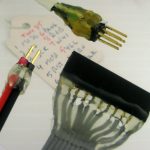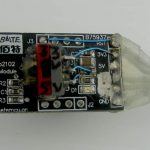 I’ve used hot melt glue for strain reliefs on connectors – typically 0.1″ headers abused as connectors – for a long time. Insulation is a secondary plus, but the primary goal was physical strengthening/protection of the quite small (and therefore weak) solder joints. Yeah, the technique is good – no cold joints – but they’re still pretty small. Cheap, works great.
I’ve used hot melt glue for strain reliefs on connectors – typically 0.1″ headers abused as connectors – for a long time. Insulation is a secondary plus, but the primary goal was physical strengthening/protection of the quite small (and therefore weak) solder joints. Yeah, the technique is good – no cold joints – but they’re still pretty small. Cheap, works great.
I’m happy with a new, slightly more sophisticated application. I’ve been soldering ribbon cable to cheap USB-TTL adapters for a long time. They’re fine for the first couple of years, but after having to repair several broken wires, I’ve started taking a longer view.
The common failure mode is due to solder wicking into the stranded wire. With a nicely soldered joint, there’s reasonable mechanical strength right where the wire goes thru the hole. The next millimeter of wire is strengthened by the wicked-in solder, so all of that is OK. But then comes the junction of the stiff, solder impregnated wire and the plain wire (typically slightly inside the insulation). That’s where the flexing happens, and that’s where the fatigue failure occurs.
 The new application of hot melt strain relief is to go far enough up the wire that the solder/no solder junction is protected. Yeah, there’s still additional flex at the very end of the hot melt, but I think that’s better than flexing at the junction. I’ll bet these don’t fail the way the unrelieved ones do.
The new application of hot melt strain relief is to go far enough up the wire that the solder/no solder junction is protected. Yeah, there’s still additional flex at the very end of the hot melt, but I think that’s better than flexing at the junction. I’ll bet these don’t fail the way the unrelieved ones do.
Maybe I’ll remember to come back here in a couple of years and report back. 🙂
